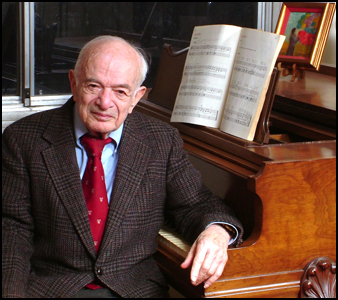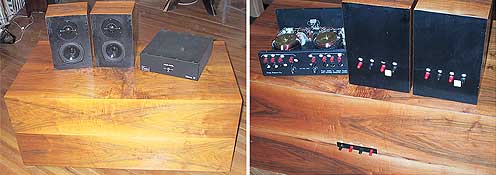Tags
audio, Bud Fried, Fried Model H, IMF, KEF, LS3/5a, Magnaplanar, Murray Zeligman, transmission line
One More Trip – The Satellite Speaker System
I had the pleasure of meeting Irving M. (Bud) Fried many years ago. Bud was the original importer of the Quad ESL’s as well as the Decca phono cartridge and SME tonearm. Bud loved music and quality audio reproduction. He eventually started his own company built some very fine loudspeakers.
I was an unknown self publishing audio journalist with a very small readership. Nonetheless, Bud was very gracious to me. He invited me to his home in Philadelphia to audition his Model H satellite speaker system. It was an audacious speaker system, using the same KEF drivers used in the famous LS3/5a mini-monitors. I owned a pair of these speakers which I imported from England, (In fact, I introduced them to the American public, at least to the few readers of my original AUDIOGRAM newsletter.) I wanted to know how the Model H compared with my LS3/5a’s. At the time the little speakers were not yet distributed in the States.
Bud had done his homework on me, and when I arrived at his home he had the Model H queued up to play Bach’s Goldberg Variations. I loved Baroque music and the Model H could easily accommodate. But they could also play as loud as you might want them with any material. They were a wonderful speaker system.
Bud knew how to build speakers and he had a very good ear. You first start with the best drivers, and the KEF drivers were sensational. (KEF was the manufacturer of the drivers, but they were developed by the BBC after extensive R & D.) Bud basically built a reasonable facsimile of the LS3/5a’s and added his famous transmission line woofer technology. How could you miss? Let me say from the outset that Bud came very close.
Here is a drawing of the Model H that Bud put in one of his newsletters. As you can see the bass module is very large. It was too large to ship so Bud sold the speaker as a kit. The bass commode was a dual tunnel arrangement with subwoofers firing out the left and right sides. Bud used the great KEF model drivers.
As you can see, the speaker system used an outboard passive crossover module. Note the very large caps in the crossover. (The system used a first order crossover between the subwoofers and the bass/midrange drivers).
It was a great attempt at reproducing the full frequency spectrum with the finest of a smooth British midrange. But, alas, the midrange was not quite up to the standard of the LS3/5a, but few speakers were in those days.
What was so great bout the Model H is that it proved the concept of mini-moniter speakers coupled with a great subwoofer, in this case two subwoofers. With time aligned and phase aligned drivers the mini-monitors become almost an ideal point source. This makes for superb stereo imaging as well a great flexibility in room placement to minimize unwanted reflections. Of course, you do get room reflections with the bass modules, but since bass module is mostly omnidirectional it has little effect on the midrange sound. In the case of the Model H, however, Bud wanted to some room refection in order to compete with the sound of the original Magnaplanars which were famous for room reflection (but stereo image suffered as a result).
For me the compromise in room reflection worked. The speaker dominated the room because of its size, but the reproduced sound did much to make the speakers disappear. Bud was a genius at experimenting with various speaker designs and formats. With the Model H he managed to bring the best of British and American design together. (I must say that he did have some help on the design from Murray Zeligman, a designer of many famous loudspeakers. In fact, my friend also developed a modification of the DYNACO PAS3x preamp that revivaled Audio Research at the time.)
Fried’s experimentation with the Model H led me to understand that small point source speakers with well designed crossover, little cone breakup, time and phase aligned drivers, and solid cabinets without resonance could offer great transparency and low coloration, provided their inherent lack of bass could be overcome. The answer was to couple these drivers with a speaker module that could reproduce low bass with an exceptional crossover, either passive or active. Fried proved the passive one could be designed to work very nicely. Today’s equivalent, I believe, is the AudioEngine A2+’s, provided it is matched properly with one or more quality subwoofers.
Hats off to one of the great legends of audio. Now deceased, Bud Fried’s speakers are still being produced, and they are still great reproducers!




I remember the Audiogram. In fact I’m almost sure I have my copies somewhere. I found this site just looking for stuff on Bud Fried who I knew well from the early 70s. And I’ve been friends with Murray Zeligman since the mid 70s having met him at Gordon Holt’s outside Philadelphia. In fact I’m usinf a set of speakers he deigned about 15 years ago. He was an unheralded audio genius.
I found the Fried article fun even though I knew it all. But there are two real errors that don’t affect the history too much but should be corrected.
First the BBC did not design the KEF drivers. KEF did although it is true KEF was an early adaptor of Bextrene developed for speakers by the BBC. The only BBC badged speakers using KEF drivers was the LS3/5A. No other BBC speakers used KEF drivers except perhaps the KEF KM1 developed for very high level monitoring for a while but it was KEF designed and badged. All other BBC speakers used main drivers developed by themselves except for the use of commercial tweeters. Yhe lone exception was the last BBC speaker, the LS5/12 using Dynaudio drivers.
Secondly, as good as Murray Zeligman was he had nothing to do with Fried designed speakers as both Bud(if he were alive) and Murray would tell you. In fact Bud, who had quite an ego(although I loved the guy) thought was just a guy who poorly copied him at first and then thought went off on incorrect tangents(Bud thought his way was the only way to accurate sound with very few exceptions) as Bud often told me after I began using Murray’s designs.
Thanks Allen. You are right about the KEF drivers. Now about the design of the Model H the picture is a little more cloudy. I want to take nothing away from Bud however. He was a great gentleman and pioneer of audio. Murray’s own designs speak for themselves. I listening to one of his prototppe speakers for quite awhile.
I was around when Bud did the model H. I got introuble when Jack Rubinson showed me a problem with the H bass crossover. The two channels were in one box with two large air core coils in parallel right next to each other causing cross modulation. I told some friends with the model H to try seperating them which improved the sound a lot. They mentioned it to Bud and he called me one Saturday morning really angry claiming I was wrong(he didn’t know about Jack).
Bud was fun. Damn I miss our conversations.
I remember the crossovers being in one container. It was very impressive to look at. But it is all about the sound. Bud was willing to experiment and sometimes he could miss the mark. But most of the time he was very good at darts. Thanks for sharing Allen. Perhaps you could write a book for us, or at least some articles?
I probably can’t write articles since I do a few reviews for an internet mag and I promised exclusivity to them for a few years.
What are they worth?? If anyone can tell me it would be greatly appreciated.
Hi, I actually built Bud’s speakers in the mid 70s. I built his personal Model H and then a number of units after that. I delivered them to his Manyunk PA warehouse where Ricard Delarosa worked doing the final assembly and testing. His offices were at the City Line Shopping Center in Philly above his family-owned movie theater.
I have to tell you that Bud got his transmission line design from Nelson Rose in Willow Grove PA. Nelson designed his woofer called the Infra Woofer. It used a JBL 2230 with a free-air resonance of 16 Hz. It was a filed line filled with poly stuffing. He drove it with a 100 watt Op-Amp Labs amplifier using a custom White Instruments 48 dB/octave passive x-over in front of the amp. It was a band-pass with user requested x-ovr points.
I worked for Nelson Rose and that is how came to know Bud Fried.
Jesse Klapholz, Melrose Park, PA 215-886-8600
“I have to tell you that Bud got his transmission line design from Nelson Rose in Willow Grove PA.”
That may be true if you are referring only to the Model H but the IMF speakers produced in England that preceded this were designed by John Wright and based on earlier work by A.R. Bailey.
Thank you for this info. Bud new how to copy great design.
Thanks so much. Sorry, I must have pressed the wrong button.
Hi Bolling, are your 2 comments mutually exclusive or can they both be true? “He was a great gentleman and pioneer of audio.” And: “Bud new how to copy great design.” Your “new” typo, not mine, but that’s not my point. lol